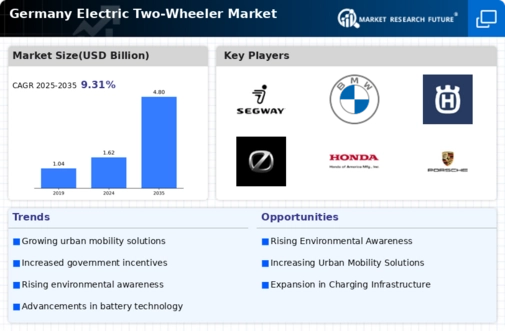The Germany Electric Two-Wheeler Market has been characterized by dynamic competition and rapid innovation as companies strive to capture the growing interest in sustainable transportation solutions. As the market expands, a range of manufacturers, both established and emerging, are vying for consumer attention with various product offerings that promise improved efficiency, innovative technology, and enhanced user experiences. The increasing demand for eco-friendly commuting options amid tightening environmental regulations and electrification goals in Germany has further fueled competition.
Companies are increasingly focusing on integrating advanced features such as smart connectivity, effective energy management, and superior design to differentiate themselves in this evolving marketplace. As urban mobility trends continue to shift, the electric two-wheeler segment is anticipated to gain traction, foster collaboration among industry players, and invite strategic investments.From a competitive standpoint, Segway has positioned itself as a notable player in the Germany Electric Two-Wheeler Market by leveraging its strong brand recognition and innovative product line. The company is well-known for its high-quality electric scooters and its commitment to providing practical mobility solutions tailored to urban environments.
Segway's strengths lie in its robust engineering capabilities, ensuring reliability and user safety while promoting a strong commitment to sustainability.
Furthermore, Segway has effectively focused on creating a user-friendly interface along with exceptional after-sales service, thereby enhancing customer loyalty within the German market. The company’s strong distribution channels and partnerships also contribute to its competitive advantage, allowing it to reach a wider audience and respond quickly to evolving market demands.In the context of the Germany Electric Two-Wheeler Market, BMW has emerged as a significant contender, leveraging its reputation for premium quality and performance. Known for its versatile product offerings, BMW has introduced electric scooters and motorcycles that cater to varying consumer preferences, establishing a strong market presence.
The company’s focus on integrating cutting-edge technology, such as advanced battery systems and smart connectivity features, has solidified its position in the market while attracting enthusiastic riders.
BMW’s strengths are not limited to product innovation; the company has also strategically engaged in collaborations and partnerships with tech companies to enhance its electric mobility solutions. Moreover, its focus on sustainability and commitment to cleaner transportation solutions align with Germany's regulatory landscape, positioning BMW favorably for future growth. The company has made efforts in mergers and acquisitions, aiming to expand its technological capabilities and strengthen its operational framework within the electric two-wheeler segment in Germany, reinforcing its competitive edge in this thriving market.














